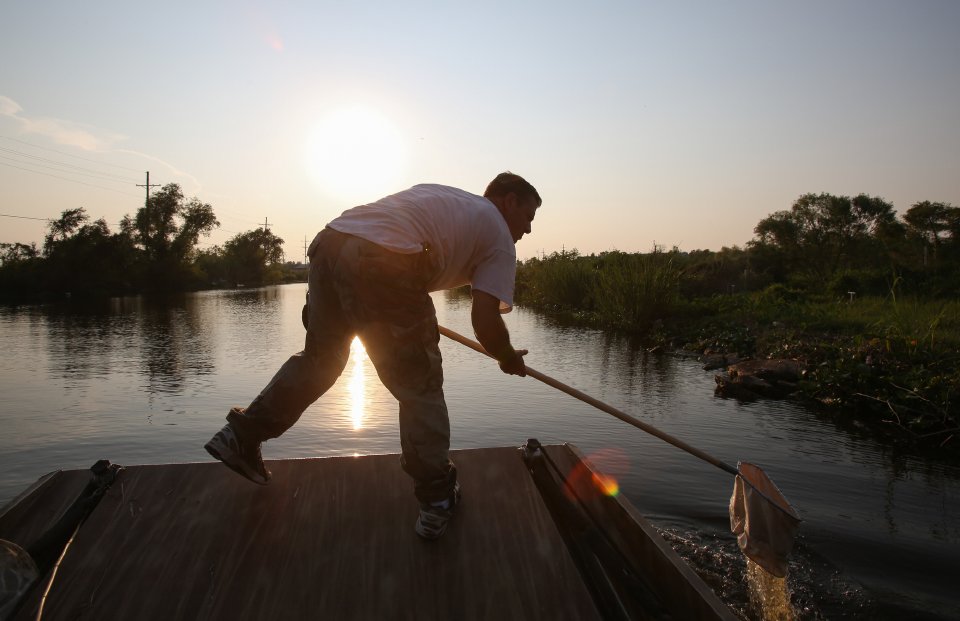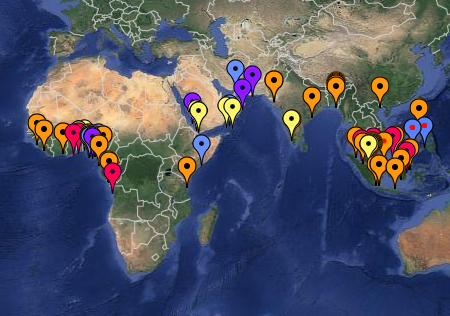airboat bug hunt
published: 8 October 2012
DES ALLEMANDS, La. (AP) — Whirligig beetles skittering atop the slow water of Bayou Des Allemands were the first target of an airboat bug hunt for the Audubon Insectarium as scientists sought to replenish its stock of swamp-swimmers.
Each of the bugs was only three-eighths of an inch long, but ripples from hundreds of random darts and circles along the bank showed up across the bayou.
The beetles, with their compound eyes divided to see both above and below the water, are tough to snag as singletons, said Jayme Necaise, the New Orleans museum’s director of animal and visitor programs.

Zack Lemann, animal and visitor programs manager of the Audubon Butterfly Garden Insectarium, scoops whirligig beetles into a net from an airboat as scientists collect bugs for their exhibits, in Des Allemands, La. Some of the bugs are raised to exhibit later at the insectarium, while others are shipped to museums. Much of an insectarium’s stock dies in a year or less, so the replenishment missions for local species are essential.
The trek to the bug-infested bayou area southwest of New Orleans is one they make six to eight nights a year during the warm weather months from May to October. Some of the bugs are raised to exhibit later at the insectarium, while others are shipped to other museums. Much of an insectarium’s stock dies in a year or less, so the replenishment missions for local species are essential.
The whirligigs’ confusion bewilders most predators, but Necaise and Zack Lemann collect them by sweeping nets back and forth from an airboat into crowds of the insects. Driver Greg Dufrene knew just where to go: He’d kept an eye out while giving daytime tours.
After chivvying a batch into a food storage box, Lemann, manager of animal and visitor programs, sniffed his fingers. The beetles emit a chemical to deter predators, but they’re no stink bugs: “It smells like sour apple candy. I love it.”
Necaise and Lemann get a few replacements, like the red-and-black wingless wasps known as velvet ants, from enthusiasts. Mostly they collect them, acquire surplus from other zoos and buy from suppliers.
In the days after the swamp trip, Lemann headed out to a pasture to hunt out fresh cowpats for the insectarium’s dung beetles and to the Audubon Species Survival Center on New Orleans’ west bank to turn over rotting wood for glossy, black patent-leather beetles.
It’s a joy of museum work, Necaise said: “When you’re in academic entomology, there’s a lot of pressure to publish. When you’re in a museum, it’s more about education and collecting for the collection.”
The insectarium, which attracts about 200,000 visitors a year, opened in 2008 to teach people about insects and their place in the world, such as pollinators, janitors and prey. But only a fraction of the 900,000 species can be shown. Many are too tiny or simply too dull — the museum needs animals that are big, brightly colored or do interesting things.
In the spring, insects are so numerous and various that a squad of volunteers helps gather them. On this night, the lone volunteer was Gordon Matherne, who brought the insectarium its first pink katydid in 2003.
He showed Lemann his collecting spots and introduced him to cousins who own Airboat Tours by Arthur Matherne, which carries the whirligig hunts, and property down the highway where, at sunset, Necaise and Lemann set up two sets of lights and sheets to bring in the big bugs.
Vertical bedsheets and tarps on the ground soon crawling with specimens.
A great thing about lights, Lemann said, is that insects will stay by them almost until dawn, letting collectors walk out to see what else may be resting on leaves, twigs or the ground. At night he can pluck grasshoppers and dragonflies off of plants and pick up big garden spiders and golden silk spiders in their webs.
He was happy with a haul of 31 water scavenger beetles, eight giant water bugs, eight dragonflies, two predaceous diving beetles, a patent-leather beetle and a spider. Dragonflies he freezes and cooks: “They taste like soft-shelled crab.”
Whirligig beetles, though small, are interesting in groups. Lemann returned to New Orleans with about 300 in two plastic boxes and two big tubs that once held refrigerated cookie dough.
Seventy-three went into the swamp exhibit. The rest are potential replacements. The beetles don’t breed in captivity, so it’s a numbers game: if two-thirds of each group die, the larger group will still have enough survivors to replenish the display.
“We’re just rolling the dice and hoping we have that really neat animal for as long as we can,” Lemann said.













